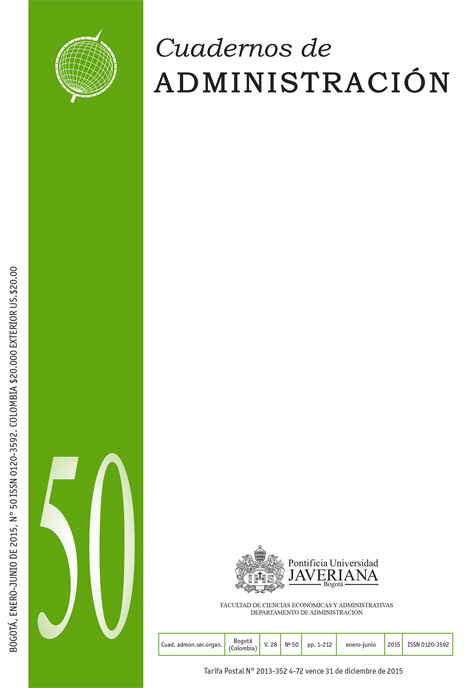Resumen
La minería de procesos es una disciplina que tiene como objetivo descubrir,
monitorear y mejorar procesos de negocio a través del análisis del
registro de los eventos del proceso que se encuentran almacenados en
los sistemas de información. En este artículo se presenta el desarrollo de
la minería de procesos y se analizan tres casos de estudio de aplicación
de esta disciplina para determinar los factores críticos que se deben
considerar para su correcto uso. A partir de lo anterior se discute sobre
los desafíos futuros que puede presentar la minería de procesos en su
aplicación en las organizaciones y las investigaciones que se requieren
para el avance de esta disciplina, que ha sido catalogada como la más
promisoria en Business Process Management.
Agrawal R., Gunopulos D., and Leymann F. (1998). Mining Process Models from Workflow Logs. En: Sixth International Conference on Extending Database Technology, (pp 469–483). Londres: Springer
Aguirre, S. (2015). Metodología para la aplicación de minería de procesos. Tesis doctoral. Pontificia Universidad Javeriana. Bogotá. 127 p.
Aguirre, S., Parra, C. y Alvarado, J. (2013), Combination of process mining and simulation techniques for business process redesign: a methodology approach, Lecture Notes in Business Information Processing, 162, 24-43.
Bozkaya M., Gabriels J. y van der Werf J. (2009), Process Diagnostics: A Method Based on Process Mining, En: Proceedings International Conference on Information, Process and Knowledge Management 2009, Cancun: IEEE
Cook J., Wolf A. (1998). Discovering models of software processes from event-based data, ACM Transactions on Software Engineering and Methodology. 7 (3),215–249.
Dumas, M. et al (2013). Fundamentals of Business Process Management. Berlin: Springer.
Dumas M, van der Aalst W.M.P y Hofstede A. (2005) Process-Aware Information Systems: Bridging People and Software Through Process Technology. New Jersey: Willey.
Grigori, D. et al. (2004), Business Process Intelligence. Computers in Industry, 53 (3), 321-343.
Herbst J. y Karagiannisb D. (2004). Workflow mining with InWoLvE. Computers in Industry. 53 (3), 245–264.
Hwang S., Wei C. y Yang W. (2004). Discovery of temporal patterns from process instances. Computers in Industry. 53 (3), 345–364.
Jans M., et al. (2011). A business process mining application for internal transaction fraud mitigation. Expert Systems with Applications, 38 (10), 13351–13359
Maruster L. y Van Beest L (2009). Redesigning business processes: a methodology based on simulation and process mining techniques. Knowledge and Information Systems, 21 (3), 267-297
Mans R., et al. (2008). Application of Process Mining in Healthcare - A Case Study in a Dutch Hospital. En: A. Fred, J. Filipe, and H. Gamboa (Eds.): BIOSTEC 2008 (pp. 425-438). Madeira: IEEE
Pinter S., Golani M. (2004). Discovering workflow models from activities’ lifespans. Computers in Industry, 53 (3), 283–296
Rebuge A., Ferreira D. (2012), Business process analysis in healthcare environments: A methodology based on process mining. Journal Information Systems. 37 (2), 99-116
Rozinat A. (2008). Discovering colored Petri nets from event logs. International Journal of Software Tools for Technology Transfer, 10 (1), 57-74.
Rozinat A., Jong I., Gunther C. (2010). Process Mining Applied to the Test Process of Wafer Steppers in ASML. IEEE Transactions on Systems Man and Cybernetics, 1-6.
Schimm G. (2004). Mining exact models of concurrent workflows. Computers in Industry. 53 (3), 265–281
Van der Aalst W.M.P et al. (2012). Process Mining Manifesto, En: Daniel, K. Barkaoui and S. Dustdar, Eds. Business Process Management Workshops (pp. 169-174), Berlin: Springer.
Van der Aalst W.M.P et al (2007). Business Process Mining: an industrial application. Information Systems, 32 (5), 713-732
Van der Aalst WMP (2015) Extracting event data from databases to unleash process mining. En: Broke J and Schmiedel T (ed) BPM-Driving innovation in a digital world. (pp. 105-128). Heidelberg: Springer.
Van der Aalst W.M.P, Schonenberg M., Song M. (2011), Time prediction based on process mining. Information Systems, 36 (2), 450–475
Van der Aalst W.M.P. (2011). Process Mining: Discovery, Conformance and Enhancement of Business Process. Berlin :Springer.
Van der Aalst, W.M.P. y Weijters A.J.M.M. (2004), Process mining: a research agenda. Computers in Industry, 53 (3), 231-244.
Van der Aalst W.M.P., Weijters A. y Maruster L. (2004), Workflow mining: discovering process models from event logs. IEEE Transactions on Knowledge and and Data Engineering. 16 (9), 1128-1142.
Van der Aalst W.M.P. and Song M. (2008). Towards comprehensive support for organizational mining. Decision Support Systems. 46 (1), 300-317.
Van Eck M., Xixi, L, Leemans S., van der Aalst WMP (2015). PM2 : A Process Mining Project Methodology. Lecture Notes in Computer Science. 9097, 297-313.
Weerdt J., Schuppa A., Vanderloock A., Baesensa B. (2013) Process Mining for the multi-faceted analysis of business processes—A case study in a financial services organization. Computers in Industry. 64 (1). 57-67.
Cuadernos de Administración se encuentra registrada bajo la licencia Creative Commons Reconocimiento 4.0 Internacional. Por lo tanto, esta obra se puede reproducir, distribuir y comunicar públicamente en formato digital, siempre que se reconozca el nombre de los autores y a la Pontificia Universidad Javeriana. Se permite citar, adaptar, transformar, autoarchivar, republicar y crear a partir del material, para cualquier finalidad (incluso comercial), siempre que se reconozca adecuadamente la autoría, se proporcione un enlace a la obra original y se indique si se han realizado cambios. La Pontificia Universidad Javeriana no retiene los derechos sobre las obras publicadas y los contenidos son responsabilidad exclusiva de los autores, quienes conservan sus derechos morales, intelectuales, de privacidad y publicidad.
El aval sobre la intervención de la obra (revisión, corrección de estilo, traducción, diagramación) y su posterior divulgación se otorga mediante una licencia de uso y no a través de una cesión de derechos, lo que representa que la revista y la Pontificia Universidad Javeriana se eximen de cualquier responsabilidad que se pueda derivar de una mala práctica ética por parte de los autores. En consecuencia de la protección brindada por la licencia de uso, la revista no se encuentra en la obligación de publicar retractaciones o modificar la información ya publicada, a no ser que la errata surja del proceso de gestión editorial. La publicación de contenidos en esta revista no representa regalías para los contribuyentes.


